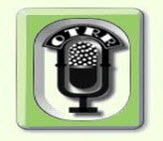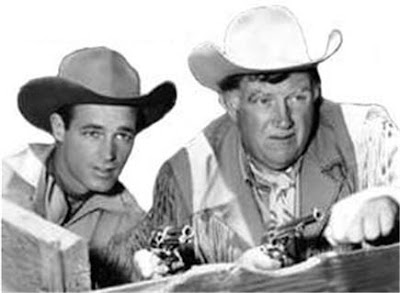.
 Tide Show, The -- Musical Program (1945-52?)
Tide Show, The -- Musical Program (1945-52?)
A fifteen-minute musical program that aired every weekday on CBS sponsored by Proctor & Gamble’’s Tide detergent. Contemporary songs from the 40s were sung by soloist, duets, or small groups. The host was Jack Smith (Smilin’’ Jack Smith) who was the male vocal for the songs. Regular female vocalists included Dinah Shore and Ginny Simms. The music was provided by Frank De Vol and his orchestra with John Jacobs as the announcer.
A typical program consisted of three or four songs, interspersed with brief commercials or banter between the players. Occasionally a ““Dramatized Song Title”” feature would present a brief play that gave hints to a song title.
Starting in 1948 and for the next few years, the program was broadcast from The Music Box Theatre on Hollywood Boulevard.
Jack Smith
Radio crooner "Smilin' Jack Smith" was a popular 40s and 50s personality, born Jack Ward Smith near Seattle, Washington, on Bainbridge Island. His father, Walter Smith, was the captain of the naval destroyer, USS Dixie. Jack was named after the fort they were stationed at the time, Fort Ward. Jack's younger brother, Walter Smith, later known as Walter Reed, became a well-respected character actor and occasional leading man. Following his parents' divorce at age 11, Jack, a good student, decided to study to be an architect, following in the path of three of his uncles. However, at age 15, he earned a job singing lead in a trio at the Ambassador Hotel's Cocoanut Grove, replacing Bing Crosby's trio, The Rhythm Boys, who had just been fired. They went on to call themselves "The Three Ambassadors". The group clicked and managed to find consistent work in swanky hotels and clubs from San Francisco to New York. The trio earned choral jobs in such movies as Walking on Air (1936), in which they sang "My Heart Wants to Dance" and appeared on the popular radio programs of the day including The Philip Morris Show, Your Hit Parade and The Kate Smith Hour. The trio broke up in 1939 and Jack, a strong baritone with a tenor lilt, went solo. Some of his popular songs would include "I'll be with You in Apple Blossom Time", "Civilization" and "Jack, Jack, Jack". He earned his own radio show in 1945, which featured such established singing stars as Dinah Shore, Margaret Whiting and Ginny Simms. Following a guest appearance in the musical film Make Believe Ballroom (1949), Jack was offered a secondary role in Warner Bros.' On Moonlight Bay (1951) opposite Doris Day. He played Doris' nerdy suitor Herbert Wakely, who loses the love game pretty easily to handsome Gordon MacRae. Radio fans of Jack did not like this unflattering image of him, and Jack, actually a handsome, strapping figure, turned down the role when it was repeated in the sequel By the Light of the Silvery Moon (1953). Radio lost its core audience with the coming of TV and Jack subsequently lost his show in 1952. He switched gears and became the TV host of the long-running show "You Asked for It" (1950) during the 1958-1959 season, which answered viewer's requests for unusual stunts, sights, etc., and stayed with it in various syndicated versions until 1991. His career lasted over six decades.
Ginny Simms
War-era songstress Ginny Simms was born Virginia Simms in Texas but raised in California, which accounts for her lack of a Southern accent in her speaking/singing voice. Though she studied piano as a child, it was her vocal gifts that launched her career, which started when she formed a singing trio while studying at Fresno State Teachers College. Ginny was performing at a club in San Francisco when she was heard by bandleader Kay Kyser. She became his featured singer and the big attraction of Kay Kyser's Kollege of Musical Knowledge, a comedy revue done in the style of a quiz show with music. In addition to radio, she kept busy recording swing and pop albums. Ginny also broke into films as a guest vocalist in three of Kyser's films for RKO--That's Right - You're Wrong (1939), You'll Find Out (1940) and Playmates (1941). After five years she decided to abandon touring altogether in the early 1940s and went solo to seek her own fame and fortune. She earned her own popular radio show and involved herself deeply in the war effort, earning praise for her tireless work. Some of her well-known recordings with and without Kyser include "Deep Purple," "Indian Summer," "I'd Like to Set You to Music," "I Can't Get Started," "I Love Paris," and "Stormy Weather." A spectacularly beautiful woman with a dazzling smile and high cheekbones, Ginny seemed made for the screen. She co-starred with Bud Abbott and Lou Costello in one of their earlier and funniest comedies, Hit the Ice (1943), and scored some important second-lead roles over at MGM with Broadway Rhythm (1944) with George Murphy and Gloria DeHaven, in which she played a movie star who sang "All the Things You Are," and the Cole Porter biopic Night and Day (1946) starring Cary Grant and Alexis Smith, in which she sang some of Porter's best loved standards ("I've Got You Under My Skin," "Just One of Those Things," "I Get A Kick Out of You" and "You're the Top"), but her career lost momentum rather quickly (the story at the time was that she had turned down a marriage proposal by newly divorced MGM head Louis B. Mayer, who retaliated by immediately dropping her contract at the studio). Ginny left Hollywood altogether in 1951 and her recording career ended not long after. She subsequently retired and ran a travel agency for a time while developing an interest in interior decorating (her first husband, Hyatt Dehn, was the man who started the Hyatt Hotel chain, for which she did much of the interior decorating). She also was involved in real estate with third husband Donald Eastvold. The mother of two sons from her first marriage, Ginny died of a heart attack in 1994 at age 78.
Dinah Shore (born Frances Rose Shore; March 1, 1917 – February 24, 1994) was an American singer,
actress, and television personality. She was most popular during the
Big Band era of the 1940s and 1950s.
After failing singing auditions for the bands of Benny Goodman and both Jimmy Dorsey and his brother Tommy Dorsey, Shore struck out on her own to become the first singer of her era to achieve huge solo success. She enjoyed a long string of over 80 charted popular hits, lasting from 1940 into the late '50s, and after appearing in a handful of films went on to a four-decade career in American television, starring in her own music and variety shows in the '50s and '60s and hosting two talk shows in the '70s.
TV Guide magazine ranked her at #16 on their list of the top fifty television stars of all time. Stylistically, Dinah Shore was often compared to two popular singers who followed her in the mid-to-late '40s and early '50s, Doris Day and Patti Page.
Frank De Vol
Frank DeVol was born to Herman Frank DeVol and Minnie Emma Humphreys DeVol in Moundsville, West Virginia on September 20, 1911. He grew up in Canton, Ohio. His father had a "pit" orchestra at the local movie house and his mother had a sewing shop in Canton. His father was also an accountant. He graduated from McKinley High School in 1929. He attended Miami of Ohio University for six weeks. His parents wanted him to be a lawyer but he wanted a musical career. He was a member of the musicians' union from the age of 14 and worked for his father in the theatre orchestra. His instruments were violin, saxophone at first. After his stint in college, he joined Emerson Gill's orchestra in Ohio and traveled the state. Later, he joined Horace Heidt's band and not only he was a musician but he became an arranger for the band. Later, he traveled with Alvino Rey's band. This affiliation led to long time friendships with the King Family. Finally, in 1943, he settled in California and started his own band appearing on KHJ radio and accompaniment to many radio shows, such as Jack Carson and Jack Smith. With the beginning of television, he moved to working on "The Betty White Show" (1958) and "The Dinah Shore Chevy Show" (1956), among others. In the 1950's, he broke into movie composing and composed the score for 50 films. In addition, he composed the music for a number of television shows, such as "Family Affair" (1966), "The Smith Family" (1971), "My Three Sons" (1960) and "The Brady Bunch" (1969). He was also a character actor and acted in both films and TV. After his first wife, Grayce, died, he married Helen O'Connell. Helen died two years later. Frank left two daughters and four grandchildren when he died October 27, 1999 in Lafayette, CA.



























